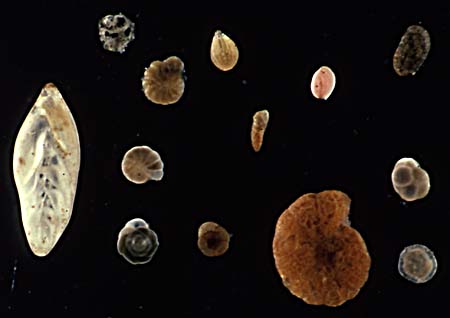
Foram shell (test) shapes, image shown with permission from the
University of California Museum of Paleontology
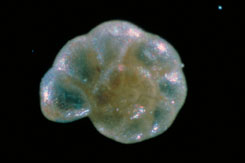
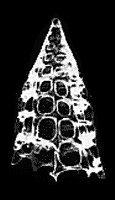
Foraminifera photo by D. B.
Scott
Ostracode: Heterocypris Radiolarian
shown with
Centre
for Marine Geology, Dalhousie fretensis, Photo by
Alison
permission from the Univ.
Univ.,
Halifax, Nova Scotia, Canada J.
Smith,
Kent State Univ. Cal. Mus. Paleo. at Berkeley
Invertebrate Paleontology Lab #13
Microfossils: Foraminifera,
Radiolaria,
and Ostracoda
Click on the lab title to see the University of
California
Museum of Paleontology web page
Read BEFORE Coming to Lab: Prothero, p. 189-213
Introduction
This week we will explore the realm of the very tiny fossils, the microfossils. Microfossils may be small, but they are tremendously useful to paleontologists. This is because microfossils are 1) so abundant that statistics can be applied to their distributions; 2) tiny samples yield thousands of specimens, and 3) many can be used not only for paleoecological information but also for geochemical information (stable and radiogenic isotope data, trace elements, heavy metals...many possibilities here to explore). There are MANY important groups of microfossils, but we will be looking at only three groups today: the Foraminifera and the Radiolaria (both groups are Protistans) and the Ostracoda (microscopic crustaceans). If you are intrigued by these fossils, you might want to consider a Micropaleontology course someday.
Kingdom Protista
Phylum Sarcomastigophora
Subphylum Sarcodina
Class Granuloreticulosa
Order Foraminiferida
Foraminifera
Cambrian-Recent
The forams are marine protists
with
a fossil record that extends back to the Cambrian. These
single-celled
organisms are an important part of the food chain in the oceans-they
are
zooplankton, feeding on diatoms and other microorganisms, and some
groups
also harbor symbiotic algae. Most are benthic, but an important
group,
the Order Globigeriina, are planktonic and used in paleoclimate and
oxygen
isotope studies of the ocean. Fossil forams from Cambrian rocks
had
shells composed simply of an organic tube with various sand grains
glued
to it (agglutinated shell). However, by late Paleozoic time,
several
types of shell appeared, including a very large form, rice-grain
shaped,
belonging to the Fusulinid forams (be sure to look at these in the type
collection). Foram protists move and capture prey using
pseudopodia
called reticulopodia. The shell, known as a "test" is species
specific
in its design, and is the basis for an enormous literature on the
biostratigraphic
applications of forams. Most foram shells are composed of calcium
carbonate or agglutinated sand grains, but the wall structures and
designs
are quite elaborate and varied. Looking carefully at a foram, you
will be able to see the opening in the shell (the aperture), and the
individual
chambers and suture lines of the shell. Note that some are
planispirally
coiled, others are trochispiral, as in snail shell coils, and still
others
are composed of linear rows of chambers (uniserial-one row, biserial, 2
rows, or triserial, 3 rows). In life, the cellular material
extends
throughout the entire test, and continues in a layer around the outside
of the test as well. Also, in life many of these forams have
long,
delicate spines that are later broken off after death.
| Examine the forams in the teaching collection and draw any two slides/specimens, labelling the aperture, chamber(s), and suture lines |

Foram shell (test) shapes, image shown with permission from the
University of California Museum of Paleontology
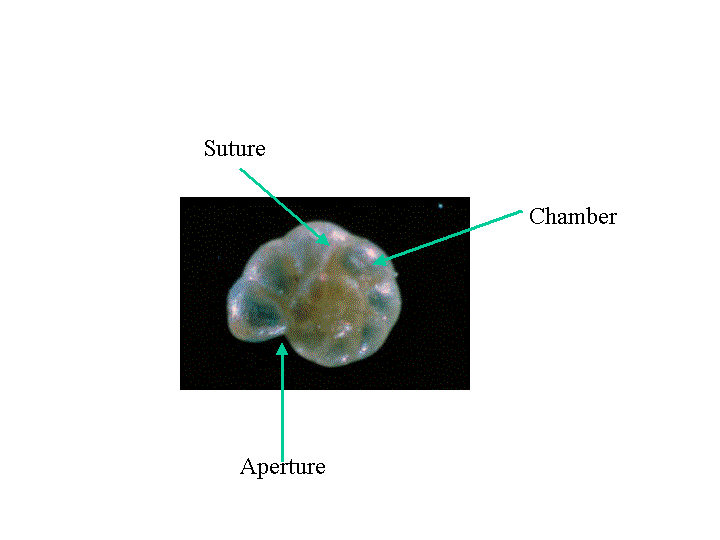
Photo Credit: D.B. Scott, Centre for Marine Geology, Dalhousie
University, Halifax, Nova Scotia, Canada
Kingdom Protista
Phylum Sarcomastigophora
Subphylum Sarcodina
Class Granuloreticulosa
Subclass Radiolaria
Cambrian-Recent
The
Radiolaria
are also microscopic marine protists that range throughout the world
oceans.
However, the shells of these protists are not made of calcium
carbonate,
but instead are composed of opaline silica (hydrated silica).
These
are about half the size of forams, ranging in size from 60 to about 200
microns. Radiolarians show strong vertical stratification in ocean
waters
to depths of 1,000 m, and are also highly abundant: enough so to
produce what is known as "radiolarian ooze" sediments on the ocean
floor!
Their abundance is strongly tied to deep ocean upwelling, where
nutrients
and dissolved silica are abundant. Some radiolarians can live in
nutrient poor water by keeping symbiotic algae (just as some forams
do).
Two common radiolarian Orders are the Spumellaria (radial-spherical
symmetry)
and the Nasellaria (conical symmetry). Radiolarians are important
microfossils in paleoclimate analysis, and have been used to
reconstruct
oxygen isotope records of the past conditions of the oceans, just as
has
been done with forams.
| Examine the radiolarians in the teaching collection and draw a radiolarian shown on the Radiolarian strewn slides. Indicate whether it is a Nasellarian or Spumellarian radiolarian. |
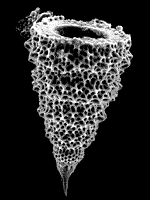 Nasellarian
Spumellarian
Nasellarian
Spumellarian 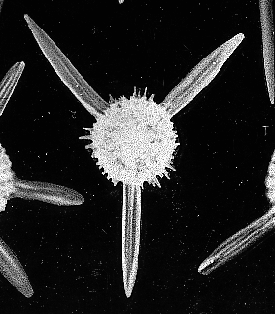
Here is a Nasellarian radiolarian (conical symmetry) and a
Spumellarian
(spherical symmetry). Images shown with permission from the
University
of California Museum of Paleontology.
Kingdom Animalia
Phylum Arthropoda
Subphyum Crustacea
Class Ostracoda Ordovician-Recent
The
ostracodes
are microcrustaceans that produce a hinged calcite shell, often
ornamented,
in which they can completely close themselves up. They live in
every
aquatic environment, from marine to freshwater to groundwater to
wetlands,
with the exception of very acidic water. They are slightly larger
than the forams (typically 500-700 microns), and can also be used as
both
paleoecological and geochemical data in paleoenvironmental and
paleoclimatic
reconstructions. The shell is commonly preserved, although often
disarticulated into two valves. When examining these bean shaped
valves, look for the adductor muscle scars. Other scars are
sometimes
visible, including the dorsal muscle scars. Ostracodes are
sensitive
to temperature and salinity in the deep ocean, and are used to map the
changing position of water masses through time. In fresh water
environments,
ostracodes are sensitive to water composition as well as
temperature.
Their rapid speciation, wide distribution, and commonly preserved
valves
make them excellent index species.
To see images of non-marine ostracodes in the NANODe (North American Non-Marine Ostracode
Database, click here.
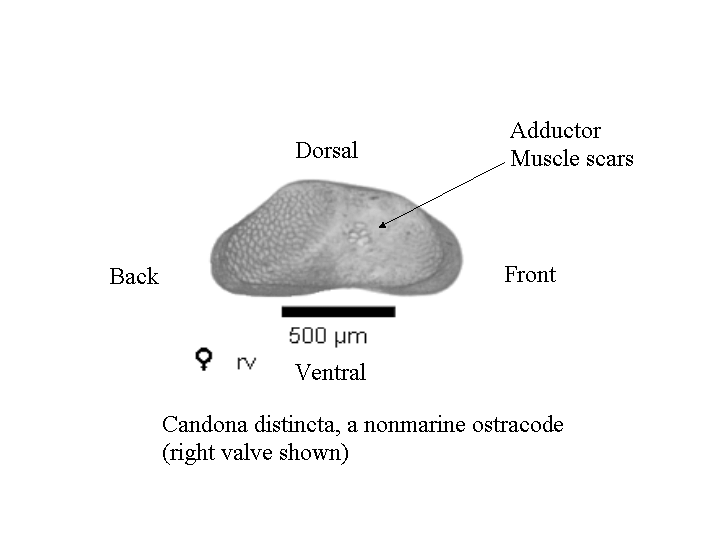
| Examine the ostracodes in the teaching collection and pick any two slides, drawing an ostracode valve from them. Label the Dorsal and Ventral sides, and the muscle scar patterns (if visible). |